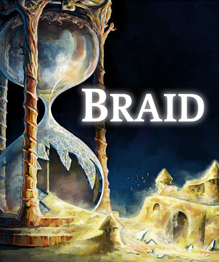A clever puzzle game, wrapped up in a student film
It is very hard to describe what makes Braid a great game. It is not enough to just say that it is a great puzzle game that involves a lot of time manipulation mechanics, because it is more unique than that. It is also not enough to say that it is an example of "games as art", because that makes it sound pretentious (which, to be honest, it is in places). The best description for Braid might be that it is a very clever puzzle game, wrapped up in a student film. It succeeds on the basic level of being very fun and challenging to play. On top of the fun gameplay, it has some quality production values, and it evokes emotions and uses symbolism in ways that are rarely seen in this form of entertainment. It's fairly short, but it is still worth your fifteen dollars if anything about it sounds interesting to you.
The goal in Braid is to collect puzzle pieces in every level, and then assemble those puzzle pieces into a series of paintings. When you complete all of the paintings, you unlock the final level and then, the epilogue. Collecting these puzzle pieces is where the game holds all of its challenge. Braid looks like a platformer, but it is not a game that requires much in the way of skill or reflexes. If you get killed, you can simply rewind time as often as you like to get back to a safe point. Figuring out how to use the game's time manipulation mechanics to collect the puzzle pieces is the true essence of the game.
If you have enjoyed mind benders like Lemmings, then Braid should be right up your alley. The puzzles are very clever and almost always look impossible at first. After staring at them and trying different solutions, you finally experience the "aha" moment where the light bulb goes off above your head and everything falls into place. It is the immensely satisfying feeling that every good puzzle game has to have in spades. If Braid has any flaws in its puzzle design, it is that it fails to adequately "train" you on some of the mechanics. At least a few of the challenges require you to almost miraculously stumble upon a game mechanic that hasn't been demonstrated to you. The most blatant example of this flaw is a puzzle that requires you to use a double of yourself to bounce enemies on top of your head. This is one puzzle where a walkthrough will come in handy.
The word "story" has to be used loosely in regards to Braid, because the game has nothing resembling a coherent narrative. Like a David Lynch film, Braid bombards you with symbolism and leaves you scratching your head at the end. The game has six worlds that play out like chapters, but they don't take place in any kind of chronological order. Each world begins with some lines of text that you can read that explain the theme for the upcoming levels. The time manipulation mechanic in these levels ties in with the texts. For example, one series of texts expresses regret over past mistakes and a longing to go back and correct those mistakes. The upcoming levels then introduce the ability to rewind time. Another series of texts wonders how life could have been different if different choices had been made. The subsequent levels give you the ability to create a short-lived double of yourself.
This is not to say that the story is worthless. It is, in fact, quite a memorable experience. It begins with what looks like a mundane quest by Tim, the main character, to save the Princess from the monster that has stolen her. By the end of the game though, it becomes apparent that it is more of an obsession than a quest. At the end is a somewhat interesting twist that gives you a decidedly different perspective on the rest of the game. Braid spoofs the plots in Donkey Kong and the Mario games and uses them to paint a portrait of a broken relationship and the emotions that come with it like guilt, regret, and denial. It is rare, if not unheard of, for a game to reach this level of artistic achievement outside of graphics and audio. And for the record, the game has quality in those areas too. The bright, 2D graphics look a lot like a stylish watercolor painting, and the beautiful soundtrack reinforces the somewhat sad tone of the game.
At times though, Braid takes itself a bit too seriously as an art form. Many of the texts that you find are written in unnecessarily cryptic language and don't even make any sense from sentence to sentence. It is in these parts where the game sometimes feels like a pretentious student film. The epilogue really makes no sense, unless you collect all of the game's hidden items, and even then, you might have to do some research on the internet to understand it.
Braid is about three or four hours long, which for fifteen dollars, isn't too bad (although it could stand to be a bit longer). It is worth buying, because there is nothing else at all like it. The puzzle-based platforming gameplay is more than solid, and on top of it is artistic achievement that is worthy of the praise that it has been receiving. It is a little too thick at times, with either its puzzles or its texts, but it is a game well worth playing. If you check it out, you will probably find that it is unlike anything else out there

0 Comments